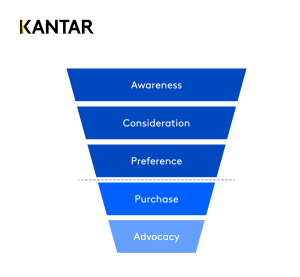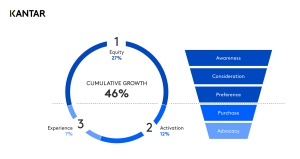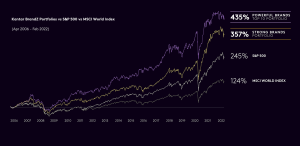
Tough times, tighter belts, shorter horizons
Speaking to many of our clients navigating the ongoing hyper-inflationary environment, all the conversation is focused on money flowing to bottom of the funnel: conversion.
For the uninitiated, the funnel refers to a framework that marketers use to bring customers into the business. Leveraging the imagery of figuratively funnelling people where you want them to go, it refers to how marketing strategies are much broader at the top of the funnel, and more focused near the bottom as you draw people closer to a moment of purchase.
In Australia, with continued fallout from the pandemic, inflation driving prices up, and a tsunami of 12 interest rate hikes in the last two years, consumers are noticeably reducing spending. And when consumers tighten their belts, so too do corporations. With revenue harder to come by, there is an increasing focus on today’s bottom line. Discretionary spending around travel and entertainment is the first to go, but as the pressure sustains, so too does investment in innovation and the future.
The corporate horizon shrinks from a five-year or three-year plan to focusing on this quarter, this month, this week. So, it is unsurprising that many marketers are focused on winning at the moment of purchase.

The evidence for better planning
As we shorten our goals, we plant the seeds for even continued difficulty in our future. This can be seen most clearly in research on the impacts of investment in the stages of the marketing funnel on growth outcomes.
Investment at the top of the funnel relates to building brand equity to drive people’s interest, consideration and intention for your products and services, while investment at the bottom of the funnel relates to purchase conversion and ongoing retention, repurchase and advocacy.

Our research shows that nearly 60 per cent of the cumulative growth effects of these activities is attributable to investments in brands. There are variations by category, of course. Airlines and hotels, for example, derive a much greater impact from investment in customer experience, while occasion driven FMCGs receive greater returns from building brand equity.
Variations aside, when times get tough and our vision grows smaller, we are leaving growth opportunities on the cutting room floor. For most categories, these opportunities are larger than the short-term gains we pursue. This means that when we steal from the future to fuel the present, we are getting negative ROI.
This can be seen on a macro level through the global Kantar’s BrandZ database tracking tens of thousands of brands globally for several decades. Businesses that build stronger brands create value more rapidly, resist market downturns better, and recover faster and further from them.

The counter-cyclicality paradox
Evidence aside, when you stop to think about it, focusing on the bottom on the funnel in a downturn is just badgering people at the moment when they are LEAST ready to buy. It is a more realistic marketing aim to target the top of the funnel, climb over silent competitors, and be positioned for that future moment when people are ready to buy again.
This points to the paradox at the heart of marketing decision-making in a downturn. As human animals, we get scared of the unknown, we worry about what might be, and our lizard brains take over. We shrink back, take fewer risks, prepare for the worst. It’s all seemingly quite sensible.
And yet… all the evidence shows us that even through the greatest economic crises of our time, the businesses that keep their eyes on the long-term reap the greatest benefits.
All of which is not to say abandon all sense and invest with abandon. But rather, take heart that a moderate point between short- and long-term is probably a lot less short-term than your immediate stresses may have you believe.
So, keep your feet on the ground, but remember the stars you are aiming for.

John Cucka
Head of Analytics,
Australia, Kantar


